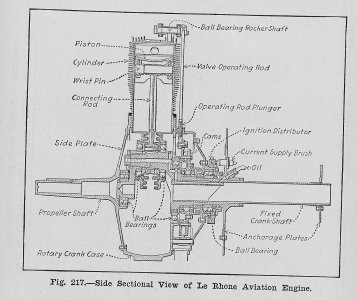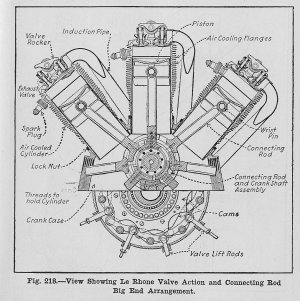- Joined
- Jul 2, 2014
- Messages
- 7,594
Well, in the early 1970's I was taking an evening metalworking class at a local high school, project based, no books. Making individual projects, use the tools you are checked out on, ask for help with the others. One of the guys attending, Scottish, would play his bagpipes before class, a real character. He was making intricate parts from blueprints, castings, and bar stock. I asked him what he was making, and he told me he was making carburetors for Le Rhone rotary engines, and then explained to me how they worked. He told me that the carburetor was not installed on the engine, it was installed on the rear side of the firewall (!) and the air/fuel mixture flowed into the center of the stationary crankshaft. When the planes were scrapped after the war, a fair amount of engines were saved from the scrap heap, but most of the carburetors were burned with the wood and fabric airplanes they were mounted to. So, he was making a run of the carburetors off the original plans. He also invited me to his nearby house after class and showed me the two complete Le Rhone rotary engines he had on display there, one on a test stand and in running condition. We did not start it at 9:00 in the evening...
Between the large amount of gyroscopic force that the engine made, the fuel system behind the firewall, the engine only having an on/off electrical system on the stick to control the spark (switch on, full throttle, switch off, no power), the fuel being gasoline mixed with castor oil, which flew out of short exhaust pipes in a circular stream around the spinning engine, and into the pilot's goggles and lungs (strong diarrhea creator), and the large amount of yaw and pitch change caused by turning the engine on and off, it was quite a handful to fly. And we have not talked about the primative aircraft, which the Wright Brothers only invented 15 year earlier. Probably more pilots got killed by the aircraft itself than being shot down by the enemy. The scarf around their necks was about the cold, open cockpits and the oily goggles, not the dapper upper class pilots of lore. It did not stay a glamour job for long, guys could (and did) die quickly in those planes.
If you ever look closely at a WWI fighter plane, they are CRUDE designs, and quickly built! The pilots were quickly trained, and in a single seat aircraft, you ultimately check yourself out to fly it. They explained how it worked, patted you on the back, and off you went. What could possibly go wrong???
Between the large amount of gyroscopic force that the engine made, the fuel system behind the firewall, the engine only having an on/off electrical system on the stick to control the spark (switch on, full throttle, switch off, no power), the fuel being gasoline mixed with castor oil, which flew out of short exhaust pipes in a circular stream around the spinning engine, and into the pilot's goggles and lungs (strong diarrhea creator), and the large amount of yaw and pitch change caused by turning the engine on and off, it was quite a handful to fly. And we have not talked about the primative aircraft, which the Wright Brothers only invented 15 year earlier. Probably more pilots got killed by the aircraft itself than being shot down by the enemy. The scarf around their necks was about the cold, open cockpits and the oily goggles, not the dapper upper class pilots of lore. It did not stay a glamour job for long, guys could (and did) die quickly in those planes.
If you ever look closely at a WWI fighter plane, they are CRUDE designs, and quickly built! The pilots were quickly trained, and in a single seat aircraft, you ultimately check yourself out to fly it. They explained how it worked, patted you on the back, and off you went. What could possibly go wrong???



